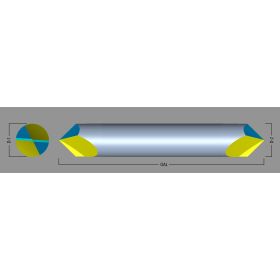Selecting The Proper Chamfer Cutter Tip Geometry
A chamfer cutter, or even a chamfer mill, can be found at any machine shop, assembly floor, or hobbyist’s garage. These cutters are simple tools which might be useful for chamfering or beveling any kind in a wide variety of materials. Many reasons exist for to chamfer an element, starting from fluid flow and safety, to part aesthetics.

Due to the diversity of needs, tooling manufacturers offer numerous angles and sizes of chamfer cutters, as well as different types of chamfer cutter tip geometries. Harvey Tool, for example, offers 21 different angles per side, which range from 15° to 80°, flute counts of two to, and shank diameters starting at 1/8” approximately 1 “.
After obtaining a tool using the exact angle they’re looking for, an individual might have to pick a certain chamfer cutter tip that could are perfect for their operation. Common varieties of chamfer cutter tips include pointed, flat end, and end cutting. These three forms of chamfer cutter tip styles, offered by Harvey Tool, each serve an original purpose.
Three Types of Harvey Tool Chamfer Cutters
Type I: Pointed
This brand of chamfer cutter is the only Harvey Tool option which will come into a sharp point. The pointed tip allows the cutter to perform in smaller grooves, slots, and holes, relative to one other 2 types. This style also enables easier programming and touch-offs, considering that the point can be simply located. It’s because of its tip that type of the cutter has got the longest duration of cut (with all the tool coming to a finished point), compared to the flat end in the other types of chamfer cutters. With a couple of flute option, this is actually the most simple type of a chamfer cutter available from Harvey Tool.
Type II: Flat End, Non-End Cutting
Type II chamfer cutters are extremely like the type I style, but feature a conclusion that’s ground down to an appartment, non-cutting tip. This flat “tip” removes the pointed area of the chamfer, which is weakest the main tool. Due to this change in tool geometry, it is given yet another measurement based on how considerably longer the tool could be when it came to an area. This measurement is termed “distance to theoretical sharp corner,” which helps with the programming in the tool. The advantage of the flat end with the cutter now enables multiple flutes to exist about the tapered profile from the chamfer cutter. With an increase of flutes, this chamfer has improved tool life and finish. The flat, non-end cutting tip flat does limit its utilization in narrow slots, but an additional advantage is a lower profile angle with better angular velocity at the tip.
Type III: Flat End, End Cutting
Type III chamfer cutters are a better plus more advanced form of the kind of II style. The kind of III possesses a flat end tip with 2 flutes meeting at the center, making a center cutting-capable sort of the kind II cutter. The guts cutting geometry on this cutter can help you cut using its flat tip. This cutting enables the chamfer cutter to lightly reduce the very top of a part on the bottom of it, rather than leave material behind when cutting a chamfer. There are numerous situations where blending of an tapered wall and floor is required, and that is where these chamfer cutters shine. The tip diameter can also be held to a tight tolerance, which significantly is great for programing it.
In summary, there could be many suitable cutters for a single job, and you will find many questions you should ask ahead of picking your ideal tool. Choosing the right angle relies on ensuring that the angle on the chamfer cutter matches the angle on the part. One needs to use caution of methods the angles are classified as out, also. Could be the angle an “included angle” or “angle per side?” Is the angle called off in the vertical or horizontal? Next, the greater the shank diameter, the stronger the chamfer as well as the longer the size of cut, but now, interference with walls or fixtures should be considered. Flute count comes down to material and finish. Softer materials tend to want less flutes for better chip evacuation, while more flutes will help with finish. After addressing all these considerations, the right kind of chamfer to your job needs to be abundantly clear.
More information about chamfer cutter go to the best website

Leave a Reply
You must be logged in to post a comment.